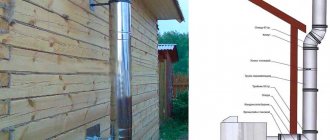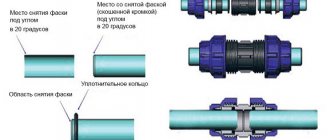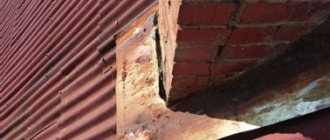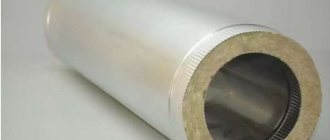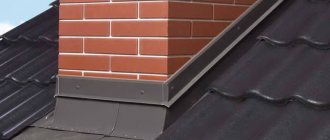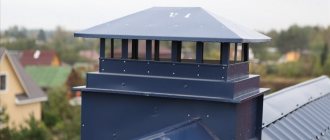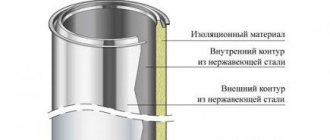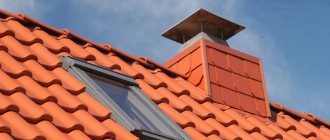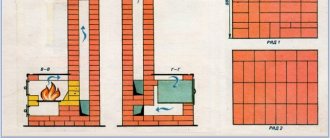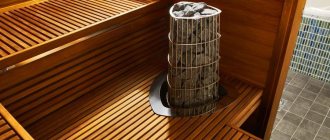Installing a chimney in general is not difficult, but there are some places, for example, passages through ceilings, that can cause difficulties if you lack experience. It is important to remember that when installing a chimney, proper waterproofing should be ensured.
Seal the gap between the pipe and the roof
No matter how tightly the pipe is placed to the roof, there will still be a gap. In rainy weather, precipitation will fall into the inner layers of the roofing pie and cause irreparable damage. That is why sealing the gaps between the pipe and the roof is an important stage in the construction of a chimney, which should not be neglected.
Methods for filling gaps
The easiest way to seal the gap between the pipe and the roof is to install a special protective element on top - an apron. You can build such an element yourself, but you will need to provide junction strips on the pipe in advance. You can do it even simpler - purchase a ready-made roofing passage made of stainless steel. As a rule, the chimney passage has a round cross-section, and the material for its production is galvanized steel. The passage is placed on the pipe, and the joint is additionally secured with a steel clamp. The galvanized passage for the chimney is shown in the figure:
Galvanized chimney passage
If you need to seal small gaps between the pipe and the roof, a silicone-based sealant is suitable. Today, any hardware store offers a huge selection of sealants; your choice must be made on a heat-resistant option.
In addition to general recommendations, there are also specific specifics for sealing cracks for various roofing materials. Therefore, the algorithm for waterproofing differs on slate, tile, bitumen roofs, as well as corrugated roofing.
Repairing leaks near a pipe
If water flows through the chimney during snow melting or rain, the reason for this is a violation of the tightness in the place where the pipe and the roof are connected. If there is a roof leak near a pipe, there are a number of ways to fix the existing problem:
- apply bitumen tape;
- install rubber cuffs;
- make and install a metal apron.
All of the above methods allow you to close the leak, so they should be considered in more detail.
Using bitumen tape
If a chimney leaks due to rain or melting snow, then the simplest and cheapest way to eliminate the leak is to make an apron from bitumen tape. To perform such work you need to use the following materials and tools:
- bitumen tape;
- scissors;
- metal brush;
- gas burner.
The cracks are sealed by taking the following measures:
- first you need to use a metal brush, which is used to clean the roof around the chimney and its outer lower part;
- Remove any remaining dust and dirt with a damp cloth;
- At the junction of the pipe and the roofing material, pieces of bitumen tape are glued. It doesn't matter which side the gaps are on. You should create a full apron around the entire pipe;
- the glued tape is heated with a gas burner, which is pressed as tightly as possible to the roof and pipe;
- to seal the joint more reliably, the tape can be additionally secured with a wooden block or board (this cannot always be done, it all depends on the roofing material).
Bitumen tape is a universal material. It can be used if a pipe or roof made of any materials is leaking. The tape is capable of performing its functions efficiently for 2-3 years (depending on the amount of precipitation and other factors).
Using the rubber cuff
If the roof is leaking near the chimney duct, then this situation can be corrected by using a rubber cuff, which can be purchased at almost any hardware store. It is installed as follows:
- a cutout is made in the upper part of the cuff, the diameter of which is slightly less than the thickness of the pipe;
- the prepared cuff is put on the outer part of the chimney duct and lowered to the roof level;
- To avoid the possibility of repeated leakage, it is necessary to use sealant at the point where the roof comes into contact with the lower part of the cuff.
Some types of cuffs are not easily glued to the roof. Some models can be screwed to the roof with self-tapping screws, but this is only possible in cases where the roof is not made of tiles or slate.
The main disadvantage of the rubber collar is that it cannot be installed on a square or rectangular pipe. What to do in such a situation? Use any other leak repair method described above and below.
Arranging a metal apron
A chimney leak at the junction of the pipe and the roof can be eliminated by installing a metal apron. This is done as follows:
- An apron is made from a thin sheet of tin, the dimensions of which must match the dimensions of the pipe. A similar product can be purchased at a hardware store;
- the upper part of the apron is attached to the pipe and crimped using a clamp. The crimping process must be carried out carefully. Gaps are not allowed;
- The lower part of the apron is installed on the roof and secured with self-tapping screws. To ensure that the damaged area of the roof does not leak, in the future the lower part of the plate should be secured on top of the roofing material, and the upper part should be removed under the sheathing.
At this point, the manufacture and installation of the metal apron can be considered complete. The sealed area will no longer cause problems. For additional sealing, the metal apron can be equipped with a rubber lining, and the contact point between the cone-shaped part and the chimney duct can be sealed with sealant.
A leaking roof near a chimney can be repaired in many ways. Such cracks are closed in 5-10 minutes, but it is worth understanding that such repairs cannot be considered high-quality. The sealed joints between the roof and vertical elements will certainly make themselves felt in a few years. Thus, such local repairs are a temporary measure. It is designed to protect against moisture entering the room until a full roofing repair is completed.
Sealing cracks in slate roofing
If it is necessary to seal a gap in a slate roof, an asbestos-cement mixture is used. The process technology is as follows:
- A round hole is cut in a steel sheet, which is used to finish the ridge.
- A ring of sheet asbestos cement is placed on the pipe.
- For complete tightness, it is necessary to seal the joint between the pipe and the roof with a solution of cement and asbestos, which are diluted in a ratio of 1 to 2.
- It is also necessary to fill the gap between the chimney pipe and the slate sheet with asbestos-cement mortar. For this purpose, you can make a temporary limiter from cardboard.
How to eliminate gaps on a tile roof
The best way to seal cracks in a tile roof is to use a cement-sand mortar. It is this method of sealing the pipe that will provide reliable protection against any type of precipitation.
Passage through metal tiles
In order to carry out waterproofing, it is necessary:
- Prepare a galvanized steel collar on the roof, thereby creating a space for filling with mortar.
- Fill the gap with cement-sand mortar, making sure that it fits tightly to the roof and chimney.
- Additionally, make an inclined surface on the collar to drain liquid.
Sealing cracks on a corrugated roof
If it is necessary to remove a smoke exhaust device through a roof made of corrugated sheets, ready-made pipe cutting Master Flash is most often used. This roofing element is very convenient to use and can be used not only for corrugated sheeting, but also for other roof materials.
Master Flash
Master Flash is an apron-cap, which is a rubber or silicone apron on an aluminum base.
Silicone Master Flash has a wider operating temperature range, but most often rubber is sufficient, which can withstand loads from -50 to +130 degrees.
Sealing cracks on a corrugated roofing looks like this:
- Make a hole in the cap so that it is slightly smaller than the diameter of the chimney.
- Put Master Flush on the pipe.
- Place a gasket under the base.
- All joints should be reliably sealed with heat-resistant silicone-based sealant.
- Attach the base to the corrugated roof with screws.
Sealing cracks in corrugated sheets
There are cases when such waterproofing is not enough and water leaks at the joint. The way out is to use a special self-adhesive tape reinforced with aluminum. It is very convenient to use, because there is no need for preheating before installation.
Choosing the right waterproofing material will help protect your roof from leaks and premature failure. Following the instructions and doing the job diligently will save you from any trouble.
What is the best thing to do?
First of all, the chimney pipe must be protected from two main negative influences: overheating and moisture ingress through the joints.
In this regard, the two main stages that must be completed in the process of insulating a chimney in a bathhouse are:
- Fire protection;
- Waterproofing.
Thermal insulation of the pipe in the bathhouse, which runs through an unheated attic, allows you to prevent heating of the structural elements of the roof, as well as to avoid the appearance of condensation, which has a very negative effect on the metal.
Important! It is worth considering the option of comprehensive insulation, since it not only solves the main problems, but also increases the level of operation.
Waterproofing also performs a very important function, because it can protect the truss system of a bathhouse, as well as other wooden elements, from rotting. Thanks to waterproofing, a pipe subject to constant wetness will not collapse.
Fire insulation
Of course, the safest option would be to install a sandwich pipe for the chimney, since this design already includes insulation.
This option is not suitable for everyone, since high-quality sandwich pipes cost a lot. That is why classic metal pipes are more popular.
Insulation of a single metal pipe is done by installing boxes and winding the pipe with basalt wool insulation.
Of course, you can do without using thermal insulation, but in this case the design will be less safe. It is worth noting that fire cutting is carried out without fail and in accordance with all the rules.
Methods of waterproofing from the ceiling and roof
Insulation against moisture penetration into the roof is carried out at the point where the pipe exits onto the roof.
The number and complexity of tests for a chimney pipe depend directly on its height and dimensions.
The fact is that the larger the pipe, the more influence it will have from wind, rainwater, and snow flows.
If you allow a misfire in the waterproofing process, natural precipitation will eventually begin to penetrate the roof, causing leaks and rotting of wooden structures.
The actual method of insulation from moisture depends on the material of the roofing and the shape of the pipe. Thus, when waterproofing round pipes, polymer grooves are used, and in the case of rectangular and square shapes, metal aprons and junction strips are used.
